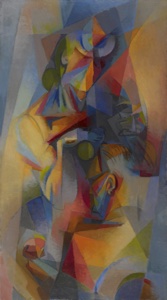Stanton Macdonald-Wright ( 1890 - 1973)
Au Café (Synchromy)
1890 - 1973 1918
Oil on canvas
© Estate of Stanton & Jean Macdonald-Wright. Photography by Dwight Primiano.
Modern Art Gallery
Description of Au Café (Synchromy)
NARRATOR: The painting you are in front of is entitled Au Café (Synchromy) and was painted using oil on canvas by Stanton Macdonald-Wright in 1918. It is 50 inches tall by 28 inches wide and is displayed in a black wooden frame.
At first glance, the painting appears to be pure abstraction, composed of randomly placed, jewel-toned prisms and planes of color. Upon closer inspection, however, two figures emerge from the vibrant rainbow of fragmented colors. In the upper half of the composition, a woman faces us wearing a small, stylishly tilted hat atop her neatly groomed hair. She raises a martini glass by its stem in her left hand. Her right hand holds a small, cylindrical object, perhaps something from which she is pouring a drink. Her head is slanted down towards a man who sits below in the bottom right section of the painting. The man’s back is turned toward us, his gaze, to the left, showing us the side profile of his face. His features are sharp and angular. The lines defining his hair sweep back away from his forehead.
Together with compatriot Morgan Russell, Stanton Macdonald-Wright founded the art movement “Synchromism” in Paris in 1912. The word means “with color,” just as symphony means “with sound.” Macdonald-Wright and Russell wanted to express the idea that music and color are similar. Synchromist paintings were based on color “scales” that were similar to musical scales. Macdonald-Wright arranged his brilliant, jewel-like pigments in staggered blocks and prismatic shapes, as if to mimic sequences of musical chords.
[End of Stop]



